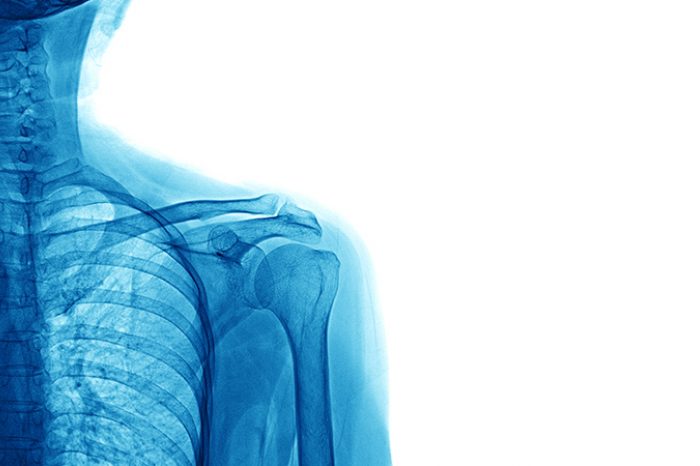
Can you avoid surgery for chronic biceps tendon pain?
A patient recently came into our clinic with a partial biceps tendon tear. He had over 2 years of shoulder pain, and had previously been told by his orthopedic surgeon that eventually his biceps tendon would completely tear and the pain would go away.
Chronic biceps tendonitis or tendinopathy is a common cause of shoulder pain, and patients often experience pain over the front of the shoulder. The biceps tendon is vulnerable as it crosses over the front of the shoulder, and repetitive stress can result in fraying of the tendon. In many patients, the pain resolves with time; however, in some cases, the tendon pain does not go away and patients must live with the pain or undergo surgery. In other cases, the diagnosis is missed and patients are told that nothing is wrong.
In our patient’s case, once we confirmed the diagnosis of a partial biceps tendon tear, we decided to proceed with a platelet rich plasma (PRP) injection. His pain of 2 years completely resolved by 6 weeks after the procedure.
Why did platelet rich plasma (PRP) work in this case, and why have you been only offered cortisone (steroid) injections at other practices?
For a long time in orthopedics we assumed that tendon pain was from inflammation of the tendon, and cortisone is an anti-inflammatory medication. However, recent studies show that most of the time tendon pain is from microscopic tears in the tendon and not inflammation. In a study by Streit and colleagues, painful biceps tendons were analyzed under a microscope and the authors found degenerative, or wear and tear, changes.
Regenerative or biologic injections (i.e. platelet rich plasma, PRP and stem cells) can help these small tears in the tendon heal. With biologics injections, you may not have to live with shoulder pain or need surgery to cut the tendon.
How do you confirm there is a biceps tendon tear when the MRI is normal?
When a MRI is normal, it does not mean that the tendon is normal. In many cases the MRI will miss a partial biceps tendon. One study by Razmjou et al showed that 73% of partial biceps tendon tears were missed on a MRI.
A complete shoulder examination will often suggest that the pain is coming from the biceps tendon or labrum, where the biceps tendon attaches. We can see the biceps tendon with ultrasound and guide a needle into the tendon. Numbing medication is then injected around the proximal biceps tendon. If all your pain goes away after the numbing medication, this confirms that the biceps tendon is the cause of your shoulder pain.
What if I have had a shoulder injection into the biceps, but it did not help?
The biceps tendon can be challenging to feel on examination. In one study out of the Mayo clinic, when clinicians were asked to locate the biceps tendon, they correctly palpated the tendon only 12% of the time.
Ultrasound-guided injections increase the accuracy of placing the medicine around the tendon. If a previous injection was not done with ultrasound and was done “blindly” by just pushing on the front of your shoulder, it may not have been injected around the tendon.
How can you ensure the platelet rich plasma (PRP) injection is going into the tear?
Ultrasound-guided injections increase the accuracy of placing these biologic injections into the tendon. All of our PRP injections are done under ultrasound guidance to accurately place the medicine into the tendon tears. The use of ultrasound to confirm that the PRP is placed accurately provides the greatest chance of success.
Carr, R. M., Shishani, Y., & Gobezie, R. How Accurate Are We in Detecting Biceps Tendinopathy? Clinics in Sports Medicine. 2016;35(1):47–55.
Dubrow SJ, Streit JJ, Shishani Y, et al. Diagnostic accuracy in detecting tears in the proximal biceps tendon using standard nonenhancing shoulder MRI. Open Access J Sports Med. 2014;5:81–7.
Razmjou H, Fournier-Gosselin S, Christakis M, et al. Accuracy of magnetic resonance imaging in detecting biceps pathology in patients with rotator cuff disorders: comparison with arthroscopy. J Shoulder Elbow Surg 2015. [Epub ahead of print].
Jacobson JA. Musculoskeletal ultrasound: focused impact on MRI. Am J Roentgenol. 2009;193(3):619–627.
Mehta P, Rand EB, Visco CJ, Wyss J. Resident Accuracy of Musculoskeletal Palpation With Ultrasound Verification. J Ultrasound Med. 2018;37(7):1719-1724.
Adductor longus selective tenotomy is a modern surgical treatment for chronic groin pain that offers faster recovery and better outcomes than traditional full release surgery. The adductor longus, an inner thigh
Read MoreDiscover how ultrasound helps diagnose plantar fat pad atrophy, a leading cause of ball-of-foot pain. Learn about symptoms, thickness cutoffs, and why early detection matters for relief.
Read More